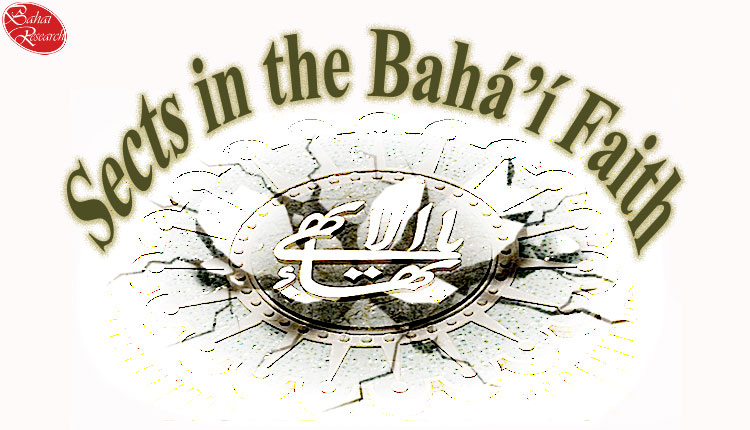Baha’i Divisions and Sects in the Bahá’í Faith
Abstract
Very recently a research scholar has submitted his thesis based on validity of the claim made by many Bahá’í scholars with regard to one of the most important beliefs in the Bahá’í Faith; the claim of unity and consequently the claim stating there is no schism within this faith. Below is his analysis and conclusion.
Sect meaning in the wording and the expression

The Bahá’í Faith introduces the unity of its faith as part of its major beliefs. It has claimed that by the teachings of its founders and leading figures, there will never be any sect of the Bahá’í Faith and that it would not be subject of schism. This idea is advocated further by emphasis on the will of Bahá’u’lláh and the will and testament of ‘Abdu’l-Bahá, referred to as the twin covenants.
The first step as we began our research was to look at the description of the term “Sect” in English dictionaries and also under sociology and religious terminology. Through this, the Bahá’í belief regarding schism within this faith is discussed below. Literary definitions of the term schism, as mentioned above in terminology, provide the essentials to distinguish various views with regards to this claim’s acceptance or rejection. Experts, both within and outside of the faith, have voiced their take on the validity of the claim of unity within the Bahá’í Faith and the legitimacy of this claim.

Mojan Momen, a Bahá’í author and activist, through the questionnaire he completed for this research indicates; “Division … is a purely description term with no specific definition in sociology or religious studies.”

“Sect” however has a specific meaning in sociology and religious studies. In his view, the difference between the wording and the expression used to identify these groups makes all the difference in authenticating this claim. By which, he is pointing out that the term sect is “… a religious group that has separated off and formed a community that is distinctive in its beliefs and practices from other groups.” His response to the question of division in Babi cause and Bahá’í cause is “No” in both cases. Even though he admits that there has been faction and division in these two religions, he stated that none of them hold up to the definition of sect, as some only exist by opposition towards the main body of the Baha’i Faith. Hence the claim stands unscratched.
Guardianship challenges after Bahá’u’lláh

Inviolable as this argument may appear at first, the researcher must inquire whether this view, taken by Bahá’ís such as Dr.Momen and the claim of impossibility of schism, promoted by most, if not all Bahá’í groups, is in fact accepted within the Bahá’í community and from one group to another, and do they consider themselves as one united faith. As we have shown the existence of a variety of religious groups, of whom nearly all are known as Bahá’ís and identify themselves as followers of Bahá’u’lláh, is considered a peak in this argument.
Historical evidences brought forward of their formation and background with reference to the Bahá’í institutions and figures that existed over time shows the division among the distinctive Bahá’í characters. For example one could say that the conflict between Abbas Effendi, and his brother; Mirza Muhammad Ali’s right at the prime of the Bahá’í Faith world introduction. This is perhaps a dark part of Bahá’í history as the intense communications among the two brothers declare a deep struggle in the nominated line of succession of Bahá’u’lláh.
As well as religious disputes the two have encountered family disputes regarding the inheritance and power. This is another recorded part of their history which has affected the way the line of succession has been handled after Bahá’u’lláh.
On the contrary to people’s expectation of Shoghi Effendi’s will; to contain instructions on who should succeed him, historical evidences from Bahá’í sources state that the safe containing his will was empty. Consequently disagreements regarding the custom that institution of guardianship undertakes originated among Bahá’í followers. The proclaimed forms included three category:
1-Collective guardianship
It means that the hands of the cause must lead Bahá’ís as a council all together.
2- A single living guardian
It refers to status of the Guardian of the Cause of God, who would carry on after Shoghi Effendi and be passed on after him.
3- A council directed by a living guardian
It means the council directed by a living guardian to lead Bahá’ís , has so far not been actually realised.

Resulted sects after Shoghi Effendi
Similarly after Charles Mason Remey, whom some have followed as the Second Guardian, divergences appeared as his followers placed different people as a living Guardian. Some of his followers claim that he should not have taken such high ranking position and that he and his successor are both regents. As explained before, there exists groups who have theoretical differences to the belief set of heterodox Bahá’ís, among them is those who bring forward various arguments to assert their choice of Remey’s successor.
I must acknowledge the approach that heterodox Bahá’ís cholars take towards these sects is that they consider these divergences from Babi and Bahá’í Faith as minor disagreements and originated from each individual’s ego. Or in some cases they are considered only as a small association or club within the Bahá’í community.
Hence the prerogative that formation of these groups does not contradict the belief in the claim of unity within the faith. While the heterodox see this as reason logical enough to prove their claim to the united, un-divided Bahá’ís the question that remains is whether the Bahá’ís whose group is among these agree on this viewpoint as well.
Conclusion
The answer to this lies in the set of beliefs not shared by these other somewhat smaller group of Bahá’ís, who despite the ignorance of the major Bahá’í group claim to still have an organizational structure of their own.
In my opinion this line of reasoning does validate the proclamation that no schism exists within the faith. Nevertheless it is obvious that if one accepts noother than itself to be part of the true definition of a term, then any group may make such claims within their faith. We have explored the facts and findings on the background of the claim.
As the evidence showed the claim was announced by ‘Abdu’l-Bahá as a statement of belief and insisted upon by the guardian through the emphasis in his writings, articles and letters. It was argued, by the Bahá’í community leaders and believers, that the origin of the claim lies within the concept of unity which is derived by Bahá’u’lláh.
Reference:

